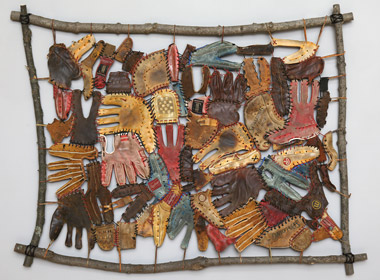Step into B. Z. Reily’s studio in Shutesbury, and enter a place where the past regains a presence. Reily works with an array of previously discarded objects to create series of sculptures—including whimsical masks, interpreted and imaginary animals, and human figures of weathered wood. But in recent wall sculptures based on traditional quilt patterns, she fabricates a kind of magic with multiple found objects.
Don’t think warm, soft, and fuzzy—or even fabric. Instead, envision patterned patchworks of metal, wood, and clay—”all the things that you wouldn’t want to sleep under,” notes Reily. She cheerfully admits to being “fabric-phobic,” but explains, “I love the process of piecing together, and piecing together found objects is not so different from quilting.”
In one of her earliest art quilts, Reily unraveled worn, sweat-stained baseball gloves, then re-stitched them into a crazy quilt pattern within a frame of tree saplings. She started another crazy quilt with blue jeans as the background, then asked friends and family to empty their pockets: “I took an informal survey—guitar picks from my husband and his musician friends, foreign coins from my traveling kids, and my own collection of keys.” And a friend contributed a pile of matchbooks. Reily arranged these enticing, tiny items into grids floating above the irregular jeans pattern to create “Pocketed Investments.”
“Log Cabin Quilt,” made of clay, wood, cardboard and assorted found objects, is based on a classic design that starts with a square in the middle and then builds outward with increasingly larger rectangles. “Flying Tin Geese” brings triangular pieces cut from cookie, tobacco, oil and coffee tins into the Flying Geese pattern, edged with a border of ski bindings thriftily salvaged from the skis she used on another sculpture. And “Manual Labor,” based on the diamond quilt pattern, incorporates small, moveable machine parts—”plus a beautiful old coffee bag,” adds Reily.
“Evening Star Quilt” combines old board games and children’s books in a visually complicated star pattern. “I was clearing out my mother’s house and I realized I just couldn’t throw out all these games. They are too wonderful, and they hold too many memories. I have that collecting disease, I guess,” she says.
This star design is particularly challenging, Reily acknowledges, with its interplay of foreground and background. And this art quilt is particularly appealing, with repeating dominoes, checkers, and Scrabble pieces pulling together the complex composition.
“A lot of times my art is influenced by people giving me something,” she notes. When a friend gave her an assortment of abandoned wooden skis, Reily sliced them up to make “Winter Totem,” based on the string or ribbon quilt pattern. “These were beautiful old, even antique skis,” she says, “and it’s probably a sin that I cut them up. But that’s the choice. I could sit and look at them piled up in the corner, or I can cut them up to make art.”
She opts for the art making, seeing her work with found objects not only as an occasion to recycle but also as an opportunity to re-animate the materials—and turn a fresh eye on things around her so as to see her world in a different way.
She aims to offer the same joy of re-cognition to viewers. “Looking at my work, people really like to recognize an object or an item after they’ve seen the whole piece,” she explains. “And my intention is to [have them] first see the work as a whole, then discover the parts and pieces.” Rather than creating a distraction, the discovery of the previous identities of found objects creates a sense of delight in the magic of makeover.
Where does she unearth her found objects? “Tag sales, thrift shops, flea markets, and my very loyal friends,” she explains. “They know I love multiples of anything.” As she speaks, she spills out a recently received bag full of little wooden hammers from “some musical instrument” and arranges them in a pattern. “Also, I’m at the age when my parents and my friends’ parents are dying or moving into assisted living, so there’s lots of old stuff coming my way,” she says. Set aside melancholia—family treasures and cherished memories become the raw materials she takes for transformation.
In her studio, what could be an otherwise unwieldy mass is organized by material. There’s the metal; wood is over here; and ceramic pieces are in that bin. Sometimes items destined for future artwork are organized by shape: “I keep long, thin pieces over there,” she notes, “so I’ll have something at hand if I need that size and shape.” And some intriguing items stand outside the usual categories: shoe forms, antique alphabet pieces and moose bones, which are perennial favorites for the children she works with as an art teacher in the Shutesbury Elementary School.
Reily favors what she calls “old methods of bolting, riveting, clamping and stitching” and avoids heavy-duty toxic adhesives, relying instead on “good old white glue.” And she is fascinated with the things people throw or give away. “The objects speak to me, they definitely speak to me,” she says. Sometimes this is because of the memories they evoke, as with the star-patterned quilt made of her childhood board games. Other times, the materials dictate what she does with them. When she was cutting up tin containers to make the “Flying Tin Geese” quilt, she realized that the metal pieces would have to be riveted together. And with “Winter Totem,” the long, thin shape of the skis directed her choice of the pattern while the unexpected, intense blue on the bottom of some skis became a key element of the composition.
Sometimes, she acknowledges, there are surprises: “You go to use something and it says, ‘No, you’re not going to do that to me.’ Then her dialogue with the material continues. In these instances, she is not just “finding” an object, but uncovering its true, new incarnation through patterns of multiples and material recombinations.



